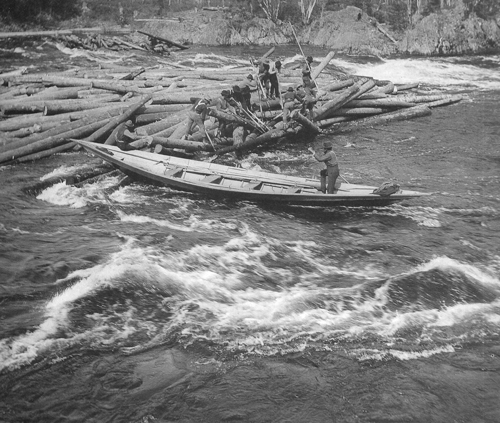B A C K T H E N
On The Wassataquoik

River drivers, armed with pick-poles and peaveys, struggle to uncover the “key log” of a “center” jam of spruce; centers built up over an undersucked log. On the Wassataquoik, “wing” jams, formed from the bank, served a good purpose by concentrating the “driving pitch” of water. Seventy or eighty men would be employed “picking the rear” of the drive, freeing the logs caught in the wings.
The drivers have arrived and will depart by batteau (or bateau or batteaux), the most historic European watercraft in North America. Batteaus were an important means of transportation in colonial America and saw heavy military use in both the French and Indian and the Revolutionary Wars. The batteau was essential to the lumbering business and attained its highest form on the Penobscot.
The batteau transported men and supplies on twisting, uproarious driving streams choked by logs and boulders. It had to be cat-quick, light of weight, and able to survive terrific punishment. Heavily freighted batteaus were poled up-river by two men using iron-shod spruce poles. When headed downstream, the men used long ash paddles. Oars were used when shuttling men from bank to bank.
A standard thirty-two-foot batteau was nearly seven feet from rail to rail, with a bottom but three feet wide and under twenty-two feet long. This great flare, in but a foot and a half of rise, gave buoyancyand stability to a loaded boat. The extreme rake of the ends allowed the boat to slide up and over obstructions. The small wetted surface aided maneuverability and poling ability.
A big batteau weighed but eight or nine hundred pounds dripping wet, and its shape permitted a dozen men to shoulder a gunwale or pole when “lugging” on a carry; Fannie Hardy Eckstorm described up-turned, many-legged batteaus, picking their way over a carry, as best resembling “huge Brobdinagian insects.” The batteau, she wrote, was shaped “to meet the stationary wave of rough water rather than the heaving wave of the sea.” The craft best shaped for the heaving wave was its cousin, the dory.
The batteau in the photo was built by Hosea B. Maynard, master driver of the West Branch in 1870.Maynard originated the exaggerated flare and bow—his boats were thirty-four feet long and carried their beam closer to the ends—and “three-streak” (plank) sides. Maynards proved superior to older Old Town and Kennebec models on the rough West Branch, eliminating many long carries and greatly expediting driving.
Other batteau builders were located in Old Town and Passadumkeag. In 1888, Guy Carlton’s Old Town shop built ninety-eight batteaus, plus many light canoes intended for river driving. His batteaus were used on the Amazon. The following items are from The Maine Mining Journal, The Mining & Industrial Journal, or The Industrial Journal, of Bangor:
H. B. Maynard, at his Broad street establishment, continues to manufacture those lumbermen’s batteaux which have made his name so famous wherever his boats are used. He turns out about seventy-five per year, many of which go to Pennsylvania, Wisconsin and other parts of the West. — Jan. 13, 1882.
H. B. Maynard, the veteran boat builder, is making twenty-five bateaux this winter at his new shop on Cumberland street, this city. — Feb. 29, 1884.
Hosea Maynard, the Bangor batteaux builder, is making a lot of twenty-five to thirty boats at his shop this winter. The excellence of Mr. Maynard’s work is attested to by a constant demand for his batteaux from lumbering regionsfar and wide. —Feb. 20, 1885.
The arrival of the West Branch drive at the Penobscot boom was the occasion of a batteau race:
Yesterday the great race began at a point two and a half miles above Oldtown. The crew of the winning boat, there being nine in the race, consisted of Sam Andrews, J. W. Solomon (champion wader in rough water ... ) and J. W. Sullivan (champion log roller) and they stand ready to challenge any crew on the river. The men have not yet been paid off and their raids on the clothing stores and other festivities are yet to come. —The [Bangor) Industrial Journal, Sept. 10, 1886.
Text by William H. Bunting from A Days Work, Part 2, A Sampler of Historic Maine Photographs, 1860–1920, Part II. Published by Tilbury House Publishers, Thomaston Maine. 800-582-1899.
